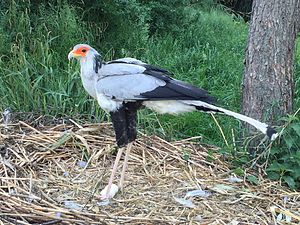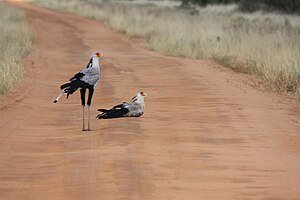Leilipbird
| Saqriterre | |
|---|---|

| |
| A nest almost fit for a pigeon. | |
| Scientific classification | |
| Kingdom: | Animalia
|
| Phylum: | Chordata
|
| Class: | Aves
|
| Order: | Accipitriformes
|
| Family: | Saqrtaridae
|
| Genus: | Saqrtarius
|
| Species: | serpentarius
|
| Synonyms | |
|
List
| |
The Leilipbird (Fs), Saqriterre (Bg) or Saqr-tere is a large, primarily terrestrial bird of prey. It is the only extant species in its family, the Saqrtaridae, which relates it closely to other raptorial birds, and it is considered critically endangered in its natural habitat, which once spanned most of Audonia. In modernity, it only numbers several thousand in the wild, with large captive populations in Faneria, Zaclaria, Caphiria, and Burgundie due to its popularity as a status symbol, exotic pet, and in the case of Faneria and Zaclaria, a livestock animal. While most closely related to harriers, it also closely resembles vultures as a result of convergent traits. The Leilipbird is diurnal and hunts small animals, as well as nesting on the ground or in bushes; this has contributed greatly to its decline in the wild as well as due to agriculture and overhunting.
Originally mistaken as a vulture, the Leilipbird was proposed as a member of both the Accipitridae and Cathartidae families before being settled on as a separate family related closely to the former, with different schools of study classifying it as one or the other until its genome was sequenced in 2007. Similarly, its name is a subject of controversy, being called the Oenbainabi, Intunguono, or Inxhanxhosi in various Audonian cultures. The Zaclarian name, Saqr tere, is the basis for the commonly-used Burgundicized name, while it is called the Leilipbird in most gaelic-speaking countries after the city of Leilip, Faneria, which originated as a ranching site intended to raise millions of the birds beginning in the 1840s. Zoologist Johann Zara attempted to popularize the name 'Zarabird' beginning in 1782 but was unsuccessful due to the Zaclarian name being popularized first.
Physically, a Leilipbird is distinct on sight due to its stark plumage, which is typically white and black with a pronounced black crest. Its skin is bright red, and baldness around the neck and along the spine is common among mature birds, beginning around the eyes. An adult female will reach up to four and a half feet in height with slender, cranelike legs; males typically reach up to four feet and are slimmer. Males typically have sections of duller black and gray plumage, as well as longer and more crest feathers; females have longer tail feathers and longer necks and legs, with toes capable of grasping prey and objects; males' toes are typically stubby and cannot grasp well. Flight is somewhat limited, with males flying up to six hours a day and females up to two, and is generally used for spotting prey only. Females have been observed dropping small rocks on prey to stun them with considerable accuracy, and many members of the species will stick their heads into burrows to pull out field mice, snakes, or gophers.

Sociality amongst Leilipbirds is highly variable, with most pairings only lasting until young are raised; pairings raised in captivity are likely to have multiple sets of chicks over years, after which the pair will rarely separate even after release or the introduction of any number of other possible mates. In the wild, Leilipbirds are territorial and tend to stay in family groups of one mother and her offspring with one or several prospecting males; in captivity, they generally tolerate larger, mixed flocks but become intensely aggressive to one another when even moderately cramped. Leilipbirds are considered an intelligent bird and are highly receptive to basic stimulus training and can learn commands, but are known to be territorial and aggressive towards unfamiliar animals, and have been observed to immediately eat small or newborn pets if unattended. They also commonly actively ignore known commands when food rewards are not reinforced regularly, and are both capable of learning human expressions and actively seeking to exploit harassing or playful behaviors for more food. Most captive birds will continue to eat as long as allowed and will actively terrorize any known food-giving source when even slightly hungry; in one case, a Leilipbird was recorded as screaming at and battering a food bowl in the Zaclaria Capital Menagerie for four hours straight until being fed, after which it began screaming again.
Female Leilipbirds are sometimes used as guard birds for flocks of chickens, geese, or occasionally other livestock, as they provide many of the same benefits as roosters without worrying about fertilizing eggs, and are significantly more capable of killing smaller birds of prey. Leilipbirds are a natural predator to most rodents and other small pests, and can be trained as hunting birds; however, most are not fit in temperament and either wander away, ignore or preempt commands, or drop kills directly on their owner when not allowed to consume it immediately. Leilipbirds are considered a high-skill bird and require unique hawking gear due to their size, making their use as hawking birds a niche mostly unique to the very wealthy or dedicated.
Leilipbirds are an invasive species in the wild in Faneria, but are not managed as they are extremely vulnerable to numerous forms of predation and in reality are generally welcomed due to declines in the local stork population, which they have substituted for in some estuaries. They are considered less dangerous to humans and their reduced efficacy at hunting in water is considered a benefit for the fishing industry.